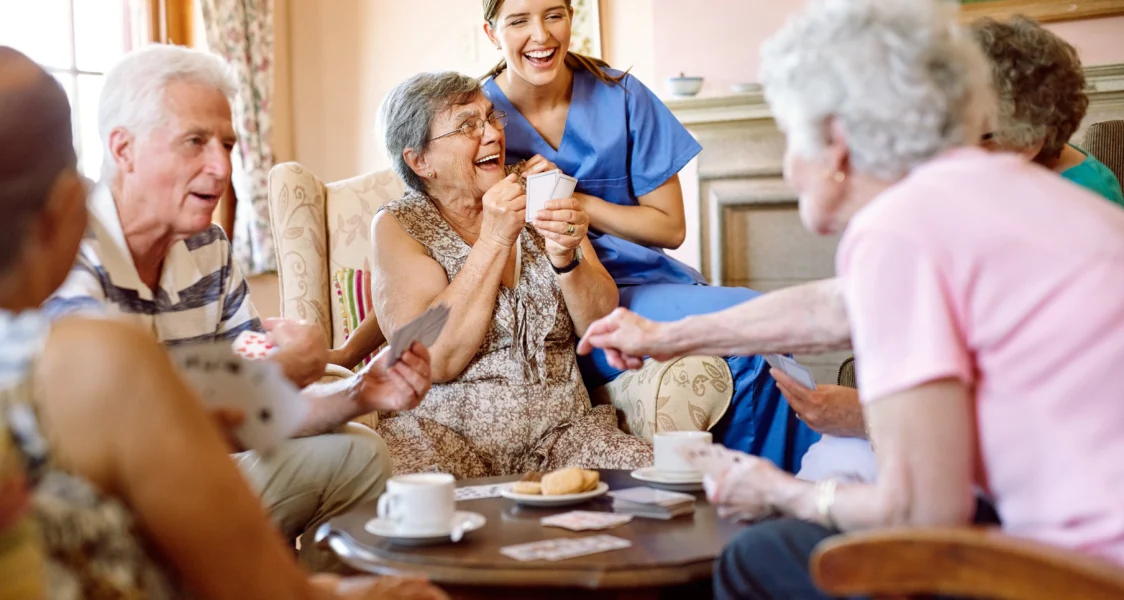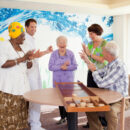Understanding and Managing Sundowning in Dementia Care
Sundowning can be overwhelming for both caregivers and individuals with dementia. Learn how to recognize triggers and implement effective strategies to manage symptoms.

Sundowning, also known as sundown syndrome, affects many people with dementia, causing confusion and agitation during the late afternoon and evening. This behavior can be challenging for caregivers, but understanding its causes and managing sundowning symptoms can improve the well-being of both the person with dementia and their caregivers. Recognizing the triggers of sundown syndrome, such as fatigue or changes in routine, allows caregivers to respond effectively and create a calming environment.
This article from Koelsch Communities explains what sundowning is, identifies common triggers, and offers practical strategies to manage symptoms. You’ll learn how to create a supportive environment at home or in a senior living community, explore the role of light therapy, and consider when medical interventions might be necessary. By the end, you’ll have clear steps to take to help your loved one experience greater comfort during difficult times of day. Let’s get started!
What is Sundowning in Dementia?
Sundowning is a term used to describe a set of behaviors that often occur in people with dementia, usually in the late afternoon or early evening. These behaviors include increased confusion, agitation, restlessness, and irritability. As someone experiences sundowning, they may become more anxious or even aggressive, making it difficult for caregivers to manage.
This pattern of behavior is linked to the way dementia affects the brain, disrupting the body’s internal clock that regulates sleep-wake cycles. As daylight fades, the brain struggles to adjust, leading to heightened disorientation and discomfort for a person with dementia. Sundowning is more common in the middle and later stages of dementia and can vary in intensity.
Recognizing the group of symptoms of someone experiencing sundowning is key to providing the right care and support. Caregivers can take specific steps to minimize triggers and calming environment to help individuals through this challenging time of day.
In What Stage of Dementia Does Sundowning Typically Occur?
The Stages of Dementia
Dementia progresses through several stages, typically categorized as early, middle, and late. In the early stage, individuals may experience mild memory loss and slight confusion but often maintain their independence. The middle stage is marked by more noticeable memory problems, difficulty with daily tasks, and changes in behavior. By the late stage of dementia, individuals typically require full-time care as they lose the ability to communicate, recognize loved ones, and manage basic functions.
Sundowning Occurrence in Mid to Late Stages of Dementia
Sundowning tends to appear in the middle and late stages of dementia. During the middle stage, increased confusion and disorientation can lead to restlessness and agitation in the late afternoon and evening. As the condition advances into the late stage, sundowning behaviors often intensify. People may become more agitated and harder to calm. Managing these behaviors early on can make a significant difference in reducing the impact of sundowning.
Common Triggers and Symptoms of Sundowning
Environmental and Psychological Triggers
Sundowning symptoms often flare up due to changes in the environment or mood. Dimming light during late afternoon and evening can confuse someone with dementia, making them more agitated. Loud background noise or too many people in the room can also increase restlessness. Sudden changes in routine—such as an unexpected visitor—can heighten confusion and frustration and lead to more pronounced sundowning behaviors.
Physical Symptoms: Restlessness, Agitation, Confusion
As sundowning sets in, physical signs like pacing, fidgeting, or repeating the same questions may appear. People might seem unusually restless, unable to sit still, or might become more irritable. Confusion is another key symptom, with individuals struggling to make sense of their surroundings, leading to increased frustration.
Symptoms of sundowning can vary greatly. Some individuals may only become mildly anxious, while others experience more severe outbursts or confusion. The frequency and intensity can shift daily, influenced by factors like sleep quality, daily routine, and overall health.
Sundowning symptoms often begin late in the day, causing confusion, restlessness, and irritability in people with dementia. Caregivers can reduce the intensity of these symptoms by creating a calm environment, establishing a consistent routine, and offering reassurance. Tracking behavior patterns over time helps in identifying specific triggers that worsen sundowning. By understanding these triggers, caregivers can adapt their approach and provide better support.
Avoiding Common Triggers: Tips for Managing Sundowning
Steer Clear of Caffeine, Big Meals, and Alcohol
Caffeine and alcohol can cause trouble sleeping, making nighttime rest difficult for someone with dementia. To promote better sleep, avoid offering coffee, tea, soda, or alcoholic drinks in the late afternoon and evening. Heavy meals can cause discomfort and restlessness, so opt for lighter dinners. Smaller portions can prevent digestive issues that might keep them awake or make them uneasy.
Reduce Overstimulation: Quiet the Noise and Calm the Environment
Loud noises and chaotic settings can overwhelm a person with dementia, leading to increased agitation. Lower the volume on TVs and radios, limit loud conversations, and reduce background sounds like running appliances. Creating a peaceful atmosphere with soft lighting and soothing music can help them feel more secure and less confused.
Skip Evening Naps and Maintain Regular Sleep Patterns
Long naps late in the day can interfere with sleep at night. Encourage brief naps earlier in the afternoon if needed, but keep them engaged during the evening. Establish a consistent bedtime routine, like reading a book or listening to calming music, to signal that it’s time to sleep. A regular sleep schedule helps regulate their internal clock and can reduce sundowning symptoms.
How to Help a Sundowning Patient with Dementia
Create a Calm Environment
Caregivers can reduce sundowning symptoms by creating a calm, predictable environment. Start by setting a consistent daily routine. Regular mealtimes, activities, and bedtime create structure, which helps someone with dementia feel more secure. In the evening, focus on calming activities like reading or listening to soft music. A soothing bedtime routine can ease the transition from day to night, which reduces anxiety and confusion.
Use Light, Sound, and Temperature
Light therapy plays a major role in managing sundowning. Encourage exposure to bright light such as sunlight during the day to regulate the body’s internal clock. In the evening, dim lights to signal bedtime. Keep background noise to a minimum, especially as the day winds down. Loud or sudden noises can increase confusion. Maintaining a comfortable temperature is also key. Too hot or too cold can lead to discomfort and agitation.
Redirect with Soothing Activities
When agitation starts, redirect attention with activities that engage the mind in a soothing way. Gentle exercises, such as a walk or stretching, can calm the body. Offering familiar objects, such as a photo album or a favorite blanket, can provide comfort. Simple activities like folding towels or sorting objects can distract and refocus their energy, helping to prevent further escalation.
Medical Interventions and Treatments for Sundowning
Prescription Medications
In severe cases, doctors may prescribe medications to manage sundowning. These might include sleep aids, antipsychotics, or anti-anxiety drugs. Medications are generally a last resort because of potential side effects, such as dizziness or increased confusion. It’s important to work closely with a healthcare provider to determine if medication is necessary and to monitor its effectiveness.
Non-Pharmaceutical Treatments
Cognitive behavioral therapy (CBT) can help people with dementia develop healthier sleep habits and reduce anxiety. CBT focuses on changing negative thoughts and behaviors that contribute to sundowning. Sessions with a trained therapist can teach relaxation techniques and coping skills that improve sleep quality and reduce agitation that leads to sleep issues.
Monitoring for Underlying Health Issues
Sundowning symptoms may be worsened by underlying issues like infections or pain. Regular medical check-ups can identify problems such as a urinary tract infection or untreated pain. Addressing these issues promptly can help lessen sundowning behaviors.
How Family Caregivers Can Support Loved Ones with Sundowning
Maintaining Consistent Communication and Reassurance
Family caregivers can help ease the anxiety of sundowning by offering calm, reassuring words. Speaking softly and using familiar phrases can comfort a loved one during moments of confusion. Even simple, consistent routines—like a nightly check-in or a familiar voice on the phone—can help reduce agitation. Physical reassurance, like holding a hand or offering a gentle touch, can also create a sense of safety.
Collaboration with Healthcare Providers and Community Caregivers
Working closely with healthcare providers and caregivers in senior living communities is essential. Regular updates from professionals can offer insight into the effectiveness of current strategies. Caregivers can also share observations, like when sundowning symptoms peak, so everyone involved is on the same page. Open communication ensures that family members and care teams can adapt routines and approaches based on the resident’s changing needs. Effective collaboration between all caregivers and healthcare providers strengthens overall care, prevents caregiver burnout, and provides better support for the individual experiencing sundowning.
Best Practices for Managing Sundowning in Senior Communities
Creating Peaceful Routines
Senior living communities use structured routines to bring predictability and calm to residents with dementia or Alzheimer’s. Consistent schedules for meals, activities, and rest reduce anxiety, especially during the late afternoon when sundowning symptoms are more likely to occur. The environment plays a significant role as well—well-lit, quiet spaces help ease the transition into evening. By adjusting lighting and minimizing background noise, communities create a soothing atmosphere to prevent agitation.
Expert Caregiver Support
Caregivers trained in dementia care can quickly identify the early signs of sundowning. By observing residents closely, they recognize when mood changes or restlessness begin and intervene with calming techniques. They also collaborate with healthcare providers to ensure personalized care for each resident based on their specific needs.
Relaxing Activities that Calm and Soothe
Music therapy, sensory rooms, and soft lighting are common tools used to calm residents during sundowning episodes. Quiet activities like listening to soothing music or spending time in sensory rooms help create a peaceful environment for relaxation.
How to Measure the Effectiveness of Sundowning Management Techniques
Tracking Symptoms and Behavior Patterns Over Time
Maintaining a detailed log of behaviors can help identify patterns and triggers associated with sundowning. Record the times when symptoms like agitation or confusion appear, what activities the person was engaged in, and the environment’s factors, such as lighting or noise. Tracking these behaviors consistently over days or weeks will give you a clearer picture of what helps reduce symptoms and what makes them worse.
Using Feedback from Healthcare Providers and Caregivers
Healthcare providers and caregivers can offer valuable insights based on their direct interactions and clinical experience. Regularly share the behavior log with them and ask for their observations. They may notice subtle changes or provide recommendations that can improve care strategies. Their feedback can help fine-tune approaches and identify any underlying health issues contributing to the symptoms.
Adjusting Interventions as Dementia Progresses
As dementia progresses, behaviors and responses to interventions will change. What worked in earlier stages may not be effective later. Continuously review the effectiveness of strategies and be open to adjusting the care plan.
Closing Thoughts
Managing sundowning in people with dementia requires a mix of practical strategies and empathy. Key approaches include maintaining a consistent routine, creating a calm environment, and reducing common triggers like fatigue and overstimulation. Techniques such as light exposure during the day and calming activities in the evening can help ease agitation and restlessness.
For caregivers and families, seeking support is essential. Whether through healthcare providers or senior living communities, access to professional advice can make a significant difference. Don’t hesitate to ask for guidance when needed. Managing sundowning can be challenging, but with the right tools and support, it’s possible to improve the quality of life for your loved one. Stay patient, observe what works, and keep adjusting to meet their needs.
Each person’s experience is different, so be flexible and open to finding the best solutions for your loved one.
About Koelsch Communities
Koelsch Communities offers a wide range of “Mom-approved” senior living options designed to create fulfilling and enjoyable experiences. With over 60 years of experience, we have built a reputation for providing top-quality care and exceptional living environments. Our communities are staffed by professionals dedicated to treating our Ladies and Gentlemen with respect and providing the special attention they need.
We pride ourselves on our high customer satisfaction, which reflects our commitment to excellence. Our experienced team ensures that every resident feels valued and cared for, promoting a thriving and supportive community atmosphere.
For more information about our senior living options and to discover how we can help you or your loved one enjoy the finest living experiences, please contact us today. We look forward to welcoming you to our community and helping you find the perfect senior living solution.
Disclaimer: This article is for informational purposes only and does not constitute medical, legal, or financial advice. It’s recommended to consult with a medical, legal, or financial professional for your specific circumstances.









